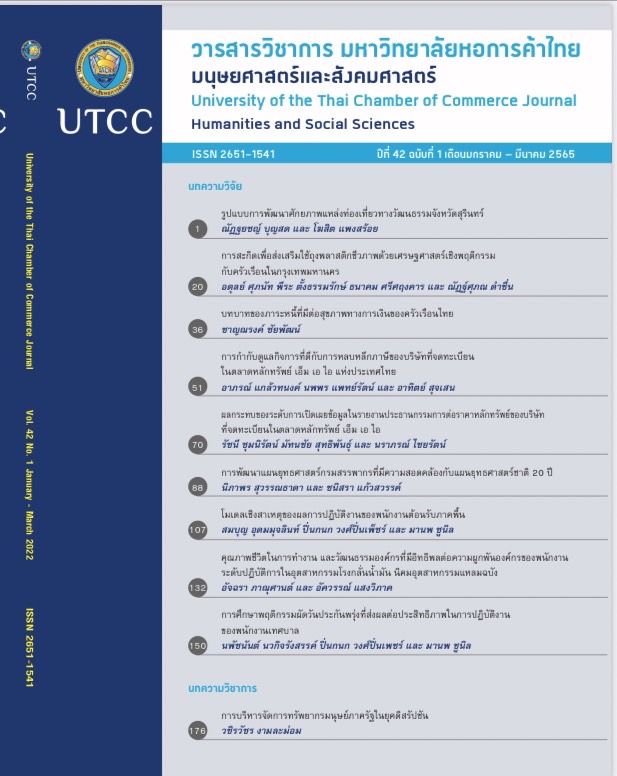Using Nudges to Encourage the Use of Bio-plastic Bags through Behavioral Economics with Households in Bangkok
Main Article Content
Abstract
This study aims to investigate how to encourage households to use bioplastic bags. Nudge
theory is applied in the form of (1) nudge using the default option to promote the use of bioplastic
bags and (2) nudge by providing positive information about the benefits of bioplastic bags or by providing
damaging information about the adverse environmental impacts of single-use plastic bags. This paper
also uses Randomized Control Trials (RCT) in Experimental Economics with 180 households in Bangkok.
The study’s key findings lead to three conclusions: (1) Nudge using the default option can increase
the opportunity of a sample to choose bioplastic bags by 19.34%. (2) Nudge with positive or negative
information can increase the opportunity of the sample to choose bioplastic bags by 39.97% and 30.41%,
respectively. (3) The consistently high price of bioplastic bags is another reason consumers are not
interested in switching to bioplastic bags. The following policy recommendations are thus proposed:
(1) In the case of department stores implementing a policy of refraining from handing out single-use plastic
bags, they may instead opt to offer bioplastic bags as a default option for consumers. (2) Department
stores can provide pictures or informational materials presenting the benefits of bioplastic bags or
the environmental impacts of single-use plastic bags to consumers directly to encourage them to choose
bioplastic bags. (3) A policy providing subsidies to reduce the cost of bioplastic bags can help motivate
consumers to use bioplastic bags.
Article Details

This work is licensed under a Creative Commons Attribution-NonCommercial-NoDerivatives 4.0 International License.
ลิขสิทธิ์ของบทความ
ผลงานที่ได้รับการตีพิมพ์ถือเป็นลิขสิทธิ์ของมหาวิทยาลัยหอการค้าไทย ห้ามมิให้นำเนื้อหา ทัศนะ หรือข้อคิดเห็นใด ๆ ของผลงานไปทำซ้ำ ดัดแปลง หรือเผยแพร่ ไม่ว่าทั้งหมดหรือบางส่วนโดยไม่ได้รับอนุญาตเป็นลายลักษณ์อักษรจากมหาวิทยาลัยหอการค้าไทยก่อน
References
กรมควบคุมมลพิษ. (2563). รายงานสถานการณ์มลพิษของประเทศไทย ปี 2562. สืบค้นจาก https://www.pcd.go.th/publication/8013/
กรีนเน็ตเวิร์ค ไทยแลนด์. (2564). มติครม.อนุมัติแบนพลาสติก4 ชนิด โฟม-ถุงหิ้ว-แก้ว-หลอด ห้ามใช้ในไทยเด็ดขาด ปี2565. สืบค้นเมื่อ 28 มิถุนายน 2564, จาก https://www.greennetworkthailand.com/เลิกใช้พลาสติก-4-ชนิด-ปี-2565/
ศตพร สภานุชาต. (ม.ป.ป.). ส่องนโยบายการพัฒนาอุตสาหกรรมพลาสติกไทย: (ร่าง) ยุทธศาสตร์การพัฒนาอุตสาหกรรมพลาสติกไทย ปี2560-2564.สืบค้นเมื่อ2ธันวาคม 2562,จากhttps://www.thaiplastics.org/img/content_attachment/attach/pdf_7.pdf
สำนักงานพัฒนาวิทยาศาสตร์และเทคโนโลยีแห่งชาติ, ศูนย์เทคโนโลยีโลหะและวัสดุแห่งชาติ. (2563). ถุงพลาสติกย่อยสลายได้สำหรับทิ้งขยะเศษอาหาร. สืบค้นเมื่อ 28 มิถุนายน 2564, จาก https://www.mtec.or.th/research-projects/39148/
Adams, M. E., McCall, N. T., Gray, D. T., Orza, M. J., & Chalmers, T. C. (1992). Economic analysis in randomized control trials. Medical Care, 30(3), 231-243.
Bordalo, P., Gennaioli, N., & Shleifer, A. (2013). Salience and consumer choice. Journal of Political Economy, 121(5), 803-843.
Chaiwat, T., Potipiti, T., Witvorapong, N., Sujarittanont, P., Sampattavanija, S., & Worathanarat, T.(2019). Default option bias in the food consumption of college students in Bangkok. Thailand and The World Economy, 37(2), 64-77.
Grunert, K. G., & Wills, J. M. (2007). A review of European research on consumer response to nutrition information on food labels. Journal of Public Health, 15(5), 385-399.
Kahneman, D., & Tversky, A. (1979). Prospect theory: An analysis of decision under risk. Econometrica, 47(2), 263-292.
Madrian, B. C., & Shea, D. F. (2001). The power of suggestion: Inertia in 401 (k) participation and savings behavior. The Quarterly Journal of Economics, 116(4), 1149-1187.
Mehrotra, A., Sorbero, M. E., & Damberg, C. L. (2010). Using the lessons of behavioral economics to design more effective pay-for-performance programs. The American Journal of Managed Care, 16(7), 497-503.
Samuelson, W., & Zeckhauser, R. (1988). Status quo bias in decision making. Journal of Risk and Uncertainty, 1(1), 7-59. doi:10.1007/BF00055564
Tangtammaruk, P. (2017). An assessment of smoking and non-smoking student preferences for the Thai smoking warning signs. Business and Economic Horizons, 13(5), 591-603.
Tangtammaruk, P. (2020). The effect of nutrition information, status quo bias, and loss aversion on the health of Thais and their consumption behaviour: a behavioural economic approach.
International Journal of Business and Globalisation, 24(1),123-138.doi:10.1504/IJBG.2020.104964
Thaler, R. H., & Benartzi, S. (2004). Save more tomorrow™: Using behavioral economics to increase employee saving. Journal of Political Economy, 112(S1), S164-S187.
Thampanishvong, K. (2015). Changing electricity consumption behavior: Is electricity conservation nudge enough?. Paperpresentedat theThailand Development ResearchInstitute. Retrieved March 24, 2020, from https://sites.hks.harvard.edu/fs/rzeckhau/status%20quo%20bias.pdf
Webber, S., & Prouse, C. (2018). The new gold standard: The rise of randomized control trials and experimental development. Economic Geography, 94(2), 166-187.

